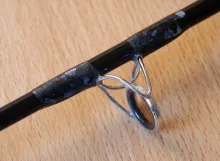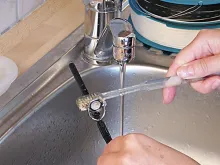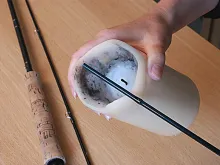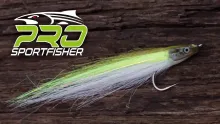The first part of a three part harmony about maintaining your precious fly fishing equipment - Rod, Reel And Line - by tropical fishing guide Roland Henrion. Learn how to prolong the lifespan of your fly rods.
Today's fishing tackle has never been better: crisp, ultra light rods, super smooth reels with multiple ball-bearings, slick fly lines, braided PE lines, you name it. Unfortunately for the angler, this high-tech gear also comes with a price.
Even though most tackle is made from high quality materials like carbon, aviation grade aluminium, stainless steel and even titanium, we practice our sport in a hostile environment: humidity, UV exposure, extreme temperatures, salt spray, mud, sand, coral... The fishing action itself is often dangerous and our precious tackle gets knocked on boatdecks or jetties, scratched on rocks or dropped in sand. Even fish push our rods and reels to extremes: a running sailfish will make your fly reel spin at speeds up to 5000 rpm... Imagine the heat build-up in the bearings!
In spite the quality of design and material fishing gear takes a beating every time we go out there. Does this mean we shouldn't invest in expensive tackle? Certainly not. First of all because quality tackle will always outlast cheap stuff, and second, because it simply feels good to fish with a beautifully crafted rod and reel. Over the years, having lived so many exciting moments together, most of us get emotionally attached to our favourite tackle and our secret hope is to be able to pass it on to our kids many years from now.
Luckily, there are - mostly simple - ways to keep our fishing tackle in good shape and ensure many years of fishing enjoyment.
Let me share my fishing guide experience with you through this series of tips.
Part 1
Rod care
Note: Rod maintenance has nothing to do with rod breakage. Anglers will always find ways to break their rods, ranging from common (car doors) to plain stupid (standing on it) or what some qualify as heroic (while fighting a huge fish). Avoiding rod breakage and rod repair are other subjects which I will discuss another time.
- Avoid at all times to knock the rod against hard surfaces. Small scratches and nicks may cause rod breakage.
- After fishing, rinse your rod and dry it with a soft cloth before putting it back into the sheath.
- Better not put a rod wet with seawater back in its sheath, as you will contaminate it with salt. If this cannot be avoided for transport reasons, wash the sheath thoroughly as soon as possible.
- Never stow a rod in its tube. This can trap humidity and cause corrosion of the guide rings. This is especially recommended for cane rods.
- At least twice a season or more frequently when fishing in saltwater, inspect the rod rings with a magnifying glass or slip a wad of cotton through them. Small scratches will hold some cotton... and also damage the line that goes through the ring. These rings should be replaced immediately.
- Check if no water seeps under the wrappings and corrode the guide ring legs. Once rust is seen, the ring should be replaced immediately.
- With cane rods, inspect the varnish regularly: if water can penetrate under the protective layer, it may cause the bamboo to rot or the strips to become unglued.
- Wash the rod with lukewarm soapy water and a soft sponge. An old tooth brush will remove the dirt from the guide rings and reel seat.
- Getting the cork grip to look like new again is easy. Take some very fine, waterproof sandpaper (the one used for car paint jobs) and a bar of ordinary hand soap. Wet the rod grip and sandpaper thoroughly. Apply soap on the sandpaper and gently rub the grip. Be careful not to scratch the rod itself or the reel seat. Rinse, let dry and admire the result.
- Small holes can be filled with natural coloured wood putty or with a mixture of cork filings and woodglue.
- Once the rod is clean and dry, spray it with plastic renovator or furnishing spray. You can apply a very light coating of fine oil on the reel seat.
- Avoid stucked ferrules by rubbing some parafin (or candle wax) on the male ferrules.
- The best way to stow a rod over long periods is to hang it in its sheath on a nail or clothes hanger inside a wardrobe. This is especially true for cane rods: leave a cane rod leaning against a wall for a long period and you will discover it will be slightly curved.
Don't miss Parts 2 & 3 about Reel and Line care.
Roland Henrion
Former fishing guide in Seychelles
The Smart Spooler line winder I designed will help maintaining your reels and lines. Check it out on www.smartfisher.com or read the review here on Global FlyFisher
- Log in to post comments

















I am amazed by the v
I am amazed by the various brutal methods recommended for cleaning cork fly rod handles (bleach, lacquer thinner, sandpaper, etc). I have been fly fishing for over 30 years and found the quickest, easiest method is to use Ronsonol lighter fluid. Wet a soft cotton cloth with the lighter fluid and rub the cork handle gently to remove dirt and discoloration of the cork. It works very well and over the years, I have observed no degradation of or damage to the cork handles on my many fly rods.
Can you use paste wa
Can you use paste wax(car) to keep your rods from cracking.
thank you now my son
thank you now my son will never know i have used his scotty rod he won in spot the fly competion trout fisher magazine when he was 10 years old 24 years ago
Here is another one
Here is another one for cleaning cork. On old rod builder told me this. Take pure bleach and a paper kitchen wipe. Put the bleach on the paper kitchen wipe and just rub as long till its clean. Use as much bleach so the wipe glides over the cork. This wont damage the cork and you dont have to sand it. Your cork fillings will also stay in. I think it will take you about a min or 5 to do the job. I have some old fiberglas rods and you will not believe how the cork will come to live. When its clean, rinse with a little warm water and kitchen soap and dry with a towel.(dont now how you spell the towel the wife uses in the kitchen to dry the plates, sorry! Dutch numnuts trying to write english) I thought you would smell the bleach after the cleaning but that is cone after an our or so. The old tooth brush is a good one to try for the next time i will clean my cork for the holes. Never thought of that before. Thanks Willem
Very helpful. I now
Very helpful. I now know how to clean the cork. I was wondering how to clean it
All sound sense.
I
All sound sense.
I have a further suggestion regarding cleaning cork grips. Use a Scotchbrite (car) finishing pad instead of the sandpaper, not forgetting the liquid soap of course.